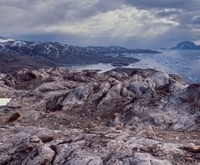
Victor Bense, a lecturer in hydrogeology at the University of East Anglia, will lead a team of researchers that will install a 10km distributed temperature sensing (DTS) fibre-optic cable along the bank of a lake in northern Greenland in 2010.
The cable will measure the temperature changes along its length and help the research team determine if and where groundwater is seeping into the lake.
Bense said the groundwater - which would likely come from melted permafrost - would be a different temperature to lake water and easily detectable by the fibre-optic cable system.
The technology, he said, works by attaching a box unit containing a laser light source and a detector to the end of the cable. The laser will send light pulses of a certain frequency and wavelength down the cable. The detector then waits to receive the backscattered light.
Bense said the time it takes for the signal to return determines the location in which the light was reflected and the frequency shifts in the reflected signal relate to the temperature of the cable.
The temperature along the cable can be quickly measured and determined by varying the wavelength and frequencies of laser pulses, he said. ‘It’s so accurate it can determine on a spatial resolution of a metre where the signal comes from.’
49 Million
The volume of ice (cubic metres) that the Findel Glacier, near Zermatt, has lost since 2005
Source: University of Zurich
The cables can measure the temperature every 30 seconds. ‘You end up with a very long time series of temperatures,’ Bense said. ‘So you can do long-term monitoring and see how things are changing over a period of time.’
Bense’s team plans to install the cable next summer and retrieve it in Spring 2011. The temperature along the cable will be monitored remotely using mobile networks.
Bense said that this is the first time anyone has been able to monitor groundwater in permafrost areas over such a great distance. More usually, researchers used thermistors to create temperature profiles. It is only feasible, he said, to install five or six of these thermistors along a 20m-long cable.
DTS fibre-optic cables have been used for years in industry to monitor temperature variations in factories to alert potential fire hazards, varying the wavelength and frequencies of laser pulses. It has only been in the last few years, mostly in the US, that scientists have considered using the technology to monitor groundwater flow.
Bense said the location in Greenland was chosen because there have already been reports of permafrost melting. Similar tests further north into the Arctic will take place in the next few years.
The information gained from the research will be fed into maps predicting likely hydrological changes of the Arctic over the next century.
It is important to know if permafrost melts into groundwater in this region, Bense said, because it could result in a large increase of freshwater eventually seeping its way into the Arctic ocean.




Project to investigate hybrid approach to titanium manufacturing
What is this a hybrid of? Superplastic forming tends to be performed slowly as otherwise the behaviour is the hot creep that typifies hot...